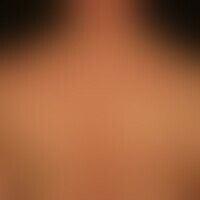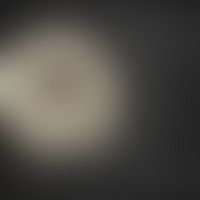Image diagnoses for "Torso", "Plaque (raised surface > 1cm)"
265 results with 950 images
Results forTorsoPlaque (raised surface > 1cm)
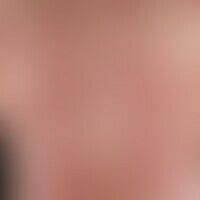
Drug exanthema maculo-papular L27.0
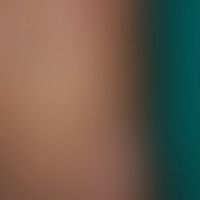
Leprosy tuberculoides A30.10
Leprosy tuberculoides: Sharplydefined asymmetrical plaques up to 8.0 cm in diameter, with pronounced edges and distinctly hypopigmented.

Nummular dermatitis L30.0
Nummular dermatitis: Extensive eczema that has been present for several months, with blurred papules and confluent plaques; distinct itching.
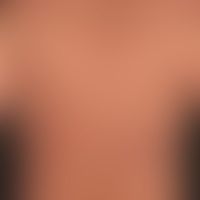
Erythema gyratum repens L53.3
Erythema gyratum repens: Anular, also garland-shaped, slightly infiltrated, reddish-brown plaques, sometimes scaly. No itching. Known bronchial carcinoma.

Basal cell carcinoma superficial C44.L
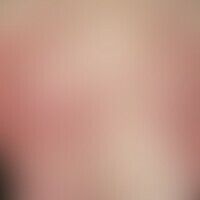
Drug exanthema maculo-papular L27.0
drug exanthema, maculo-papular. multiple, acute, since 4 days existing, generalized, symmetrical, initially isolated, 0.1-0.2 cm large, later on large, about 30 cm large, homogeneous, marginally bizarrely dissected, smooth, red spots. no fever, no lymphadenopathy. occurs 6 days after taking non-steroidal anti-inflammatory drugs due to a sports injury.

Atopic dermatitis (overview) L20.-
atopic dermatitis: eminently chronic dermatitis, with blurred, itchy, red, rough, flat plaques. known (only slightly pronounced) rhinoconjunctivitis allergica. IgE normal. no atopic FA. DD: a seborrhoid form of psoriasis can be excluded . R morphologically, a tinea corporis should be considered.
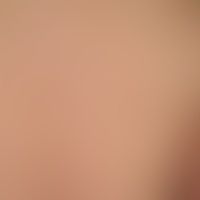
Lichen sclerosus (overview) L90.4
Lichen sclerosus et atrophicus: extragenital infestation. Monotopic infestation.

Blaschko lines
Blaschko lines: Naevus verrucosus: bizarre swirled pattern of this congenital epidermal nevus, which is oriented to the Blaschko lines.

Pityriasis rubra pilaris (adult type) L44.0
Pityriasis rubra pilaris, erythrodermalmaximum variant of pityriasis rubra pilaris.
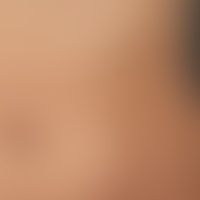
Nipple accessory Q83.3
Nipple, accessory: solitary, 0.8 cm high, symptomless, brown plaque with a decentralized pointed conical papule and coarsely felted surface; previously known circumscribed scleroderma.

Netherton syndrome Q80.9
Netherton syndrome: clinical picture already manifested in childhood with the formation of large, also circulatory, garland-like, brown-red or red surface-rough, scaly plaques; numerous type I sensitizations.
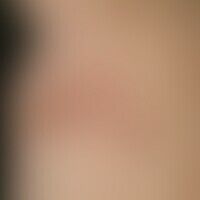
Ilven Q82.5
ILVEN: Clinical findings in a 17-year-old adolescent with erythematosquamous and papulokeratotic, locally verruciform skin lesions on the left side latero-thoracic and on the back.
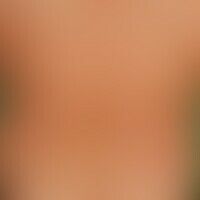
Psoriasis vulgaris L40.00
psoriasis vulgaris. psoriasis guttata. 48-year-old patient. discreet inpatient psoriasis vulgaris (elbow, capillitium), known for about 10 years. exanthematic relapse after streptococcal infection (angina tonsillaris). the figure shows a still relapse-active (see numerous spot-shaped psoriatic foci) exanthematic psoriasis vulgaris with small, scaly, reddened papules and coin-sized plaques.

Juvenile xanthogranuloma D76.3
Xanthogranulom juveniles (sensu strictu). solitary, soft elastic, yellowish, completely painless plaques. no darier sign! 8-month-old female infant. size growth in the first months of life.

Circumscribed scleroderma L94.0
Circumscribed scleroderma (plaque-type): Extensive whitish plaques in the area of the back in young patients, continuously progressive for 10 years.
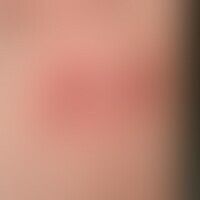
Mycosis fungoides C84.0
Mycosis fungoides, detail enlargement: Coin-sized oval plaques with atrophic surface and parchment-like folding on the lower leg of a 70-year-old female patient.





